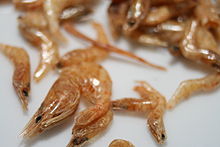Dried shrimp
| Dried shrimp | |||||||||||||||||
 |
|||||||||||||||||
| Chinese name | |||||||||||||||||
|---|---|---|---|---|---|---|---|---|---|---|---|---|---|---|---|---|---|
| Traditional Chinese | |||||||||||||||||
| Simplified Chinese | |||||||||||||||||
| Hanyu Pinyin | xiā mǐ | ||||||||||||||||
| Cantonese Yale | hā máih | ||||||||||||||||
| Literal meaning | shrimp rice | ||||||||||||||||
|
|||||||||||||||||
| Vietnamese name | |||||||||||||||||
| Vietnamese | tôm khô | ||||||||||||||||
| Thai name | |||||||||||||||||
| Thai | กุ้งแห้ง | ||||||||||||||||
| RTGS | kung haeng | ||||||||||||||||
| Korean name | |||||||||||||||||
| Hangul | 마른 새우 or 말린 새우 or 건새우 |
||||||||||||||||
|
|||||||||||||||||
| Indonesian name | |||||||||||||||||
| Indonesian | ebi | ||||||||||||||||
| Transcriptions | |
|---|---|
| Standard Mandarin | |
| Hanyu Pinyin | xiā mǐ |
| Yue: Cantonese | |
| Yale Romanization | hā máih |
| Jyutping | haa1 mai5 |
| Southern Min | |
| Hokkien POJ | hê-bí |
| Transcriptions | |
|---|---|
| Revised Romanization | mareun sae(-)u or mallin sae(-)u or geon sae(-)u |
| McCune–Reischauer | marŭn saeu or mallin saeu or kŏn saeu |
Dried shrimp are shrimp that have been sun-dried and shrunk to a thumbnail size. They are used in many Asian cuisines, imparting a unique umami taste. A handful of shrimp is generally used for dishes. The flavors of this ingredient are released when allowed to simmer.
In Chinese cuisine, dried shrimp are used quite frequently for their sweet and unique flavor that is very different from fresh shrimp. They have the coveted umami flavor (or so-called "fifth taste"). It is an ingredient in the Cantonese XO sauce. Dried shrimp are also used in Chinese (mostly Cantonese) soups and braised dishes. It is also featured in Cantonese cuisine, particularly in some dim sum dishes such as rolled and rice noodle roll and in zongzi. Despite the literal meaning of the name Chinese name xiā mǐ ("shrimp rice"), it has nothing to do with rice other than the fact that the shrimp are shrunk to a tiny size similar to grains of rice.
Dried shrimp are also used in Korean cuisine, where they are soaked briefly to reconstitute them, and are then stir-fried with seasonings—typically garlic, ginger, scallions, soy sauce, sugar, and hot peppers—and served as a side dish. It is called "mareunsaeu bokkeum" (hangul:마른새우볶음) in Korean. They are also used in some Korean braised dishes (jorim) and used for making broth.
Dried shrimp are used in Vietnamese cuisine, where they are called tôm khô, and are used in soups, congee, fried rice, or as a topping on stirfries (Mì Xào) or savoury snack items. They are also commonly eaten as snacks.
The Chinese living in Malaysia, especially those of Peranakan descent, developed sambal udang kering, which uses dried shrimp. It can be served as pub food.
...
Wikipedia
